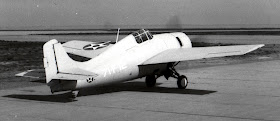In the end, the markings indicated what carrier the airplane was flying from, which of the three-plane sections it was assigned to, and which plane it was in a section. Diagonal stripes on the wing provided a reference for the wingmen in flying formation. For more, see http://www.researcheratlarge.com/Aircraft/YellowWings/index.html
This marking of each airplane in accordance with its position in each section was reasonably practical at the time because the airplanes were relatively simple at the time and therefore close to 100% available. However, the high visibility and detailed marking would be a liability in wartime.
As a result, in 1940 the Navy decided to transition to a more subdued paint scheme and markings, first (and briefly) to an all-aluminum paint scheme and then to all-gray one at the end of 1940. I can't be sure, but this picture taken in March 1941 of an early F4F in test at NACA Langley looks like it is painted in the aluminum scheme:
Note that the national insignia is in four locations on the wings and there isn't one on the side of the fuselage, only "U.S.Navy."
This is a simplified timeline of the various paint and marking configurations through 1943*:
Overall light gray, four-place insignia including the fuselage, white unit (VF-71) and airplane number markings
B:
Blue gray over light gray, four-place insignia including the fuselage, white unit (VS-2 and VF-2) and airplane number markings
C:
For a few months after Pearl Harbor, the powers that be thought that blue-on-blue ("own goal") incidents might be minimized by increasing the size of the markings and adding tail stripes and another pair of national insignias to the wings. One unintended consequence was that the red circle in the US national insignia was even more likely to be taken for the Japanese "meatball." Carrier captains were not enthusiastic about the visibility of the markings either so canvas covers were devised to cover them when the aircraft were parked on deck.
Note that the side markings are black on this airplane and the squadron number has been omitted.
D: The six-place configuration of the national insignia was retained but all red was deleted:
E: With the introduction of the reduced visual signature tri-color scheme, the number of national insignia was once again reduced to four.
Note that this is the Norfolk repaint of the original paint scheme (see http://tailspintopics.blogspot.com/2010/01/ww-ii-color-scheme-anomaly.html). I don't have an explanation for the brilliant white side markings that include the squadron number other than VF-17 hadn't arrived in the war zone yet. There was not only no reason to conceal the airplane identification but some benefit to doing so (increasing the likelihood of joining up on the right section leader and being dissuaded from buzzing, or flathatting as it was known then).
F: For some reason, the lesson about not having red markings in the Pacific theater was forgotten and the national insignia was briefly changed in mid-1943 to add a red surround along with white bars.
G: The red was replaced by blue:
Note that compliance with the directives shown on the timeline above was delayed by months in some instances. Except for deletion of red markings, which might have begun to occur even before authorization, there was usually no urgency to comply not to mention capability to do so. Repaint would be accomplished at the next overhaul, which might be a year or more in the future. Production changeover also required time for the manufacturer to create the necessary documentation, receive approval for it, and implement it, preferably after using up existing inventory of parts painted in the old scheme. Exceptions were therefore not uncommon. For example, in this widely published picture of Jim Thatch and Butch O'Hare reportedly taken in April 1942, the national insignia is missing from the upper right wing. This suggests that when the change to larger and six-place insignia and to add rudder stripes was dictated four months earlier, the squadron painted on the stripes (and subsequently deleted the squadron number from the fuselage) but didn't bother to add the additional national insignia or increase the size of the existing ones.
Scott Tait asked about the validity of six-place national insignia with a white bar, no surround. As it happens, at least VMF-222's Corsairs in the Solomons were marked that way. Whether they didn't have blue-gray paint to mark out two of the insignia, didn't want to add red to the insignia, etc. is not known to me. Note also that this particular insignia and arrangement also skips step E, going directly from D to an approximation of F/G.
* There is a similar post on this subject on my U.S Navy Aircraft History blog: http://thanlont.blogspot.com/2011/06/brief-f4u-corsair-oriented-history-of.html

















































